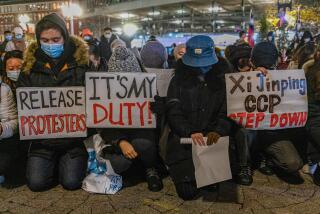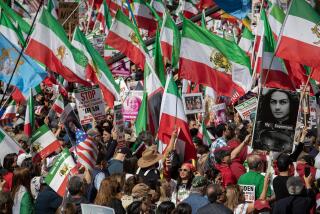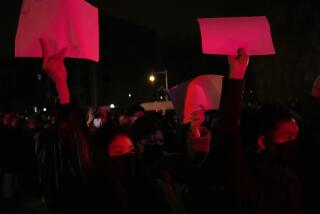Defiance, crackdown spill over from Tibet
XIAHE, CHINA — The spread of protests from Lhasa, the Tibetan capital, to neighboring communities and now Gansu province represents a crisis for a government eager to project an image of friendly confidence and cultural refinement in advance of the Beijing Olympics.
On Saturday, a massive police presence could be seen blanketing Xiahe, a holy city outside Tibet that houses the sprawling Labrang Monastery complex, one of the most revered in Tibetan Buddhism.
By early today, the cordon in Xiahe had tightened further as English-speaking police were stopping all vehicles for miles and forcing foreigners to turn around or, if they were on local transportation, to climb down.
This followed demonstrations involving an attack on a police station by thousands of people and the raising of a banned national Tibetan flag.
Twenty people were arrested in the ensuing violence, the London-based Free Tibet Campaign said, and a local official said seven people were injured, as authorities scrambled to quell the worst protests against Chinese dominion over Tibet in two decades.
The crackdown followed efforts by authorities in Lhasa to contain six days of violence. “They are in the process of restoring order, but it is not complete,” a Western aid worker living in Lhasa said.
The government has reported 10 deaths in Lhasa resulting from the protests, which it blamed on rioters setting fires. The self-proclaimed Tibetan government-in-exile, based in India, said the figure was 30, and other estimates ran higher.
Lhasa residents reached by phone said the city was under a near state of emergency with people afraid to go out.
Late Saturday, there were still small signs of rebellion in Xiahe. As undercover police prowled through crowds of pilgrims bedecked in traditional Tibetan clothing, a monk in a bright purple robe looked around to make sure no one was watching. Then he smiled defiantly and raised his fist.
Although the police presence in Xiahe was designed to intimidate residents, it also suggested how worried and insecure Beijing is at the prospect of losing control, analysts said.
“The fact that it’s now happening at the far reaches of Tibet must be very serious for the authorities,” said Robert Barnett, a professor at Columbia University. “It does seem like we’re entering a new chapter. . . . This sounds like a real political challenge to the government.”
The latest unrest was sparked Monday, when 300 monks in Lhasa urged Beijing to release several imprisoned colleagues on the anniversary of a failed 1959 uprising against Chinese rule. Protests then spread to other monasteries around Lhasa, then farther afield. On Saturday, sympathy demonstrations were reported in Australia, India and Nepal against Chinese embassies.
The rolling protests underscore the shortcomings of a ruling strategy based on fear, intimidation and tight control over Tibetan culture and religion, some analysts and rights groups said, which has failed to win the hearts and minds of Tibetans in the half-century since China annexed the region.
The unrest in Xiahe reportedly started Saturday morning after several hundred monks marched out of the Labrang Monastery, gathering supporters along the way for what was initially a ceremony of chanting and incense-burning.
By midafternoon, roadblocks were turning back all cars on the main road to the Labrang temple. Convoys of police cars patrolled a smaller road on the edge of town.
Farther down the steep valley lined with scrubby brown vegetation and small patches of ice, a convoy of military police raced toward Xiahe as two fire engines with water cannons rumbled in their wake followed by 15 large army trucks.
“There has been great trouble yesterday and today,” said the monk in the purple robe, who declined to identify himself for fear of retribution.
“It’s been bad,” said a robed colleague, crossing his arms on his chest. “Four people were shot.”
As with many reports in recent days, his claim could not be independently verified. An official at the Xiahe County People’s Hospital said Saturday that seven people were injured in the morning rampage, which he blamed on the monks.
Others blamed authorities. “The police were extreme,” said a businessman who shares his time between Xiahe and Lhasa, declining to identify himself for fear of retaliation. “I was on the spot, and it was two hours of chaos.”
The Tibetan Center for Human Rights and Democracy, an activist group, citing sources, said police and paramilitary forces fired tear gas and live ammunition into the air in a bid to disperse the crowd.
Even as Beijing has tried to block information about the last six days of unrest through telephone taps, Internet filtering and travel restrictions, it is being frustrated by some of the very advances it is promoting.
Along both sides of the road leading up to Xiahe from the capital city of Lanzhou, the mud walls of impoverished ethnic Tibetan villages are lined with giant hand-painted advertisements for cellphone and Internet services offered by state-owned companies. This proliferation of communication devices has made it far easier for Tibetans to share with the world details of this crackdown than during previous rounds.
“Protests have taken place in Tibet for years, but they’re only now getting reported,” said Tsering Tashi, London-based representative of the Dalai Lama with the Office of Tibet. “That’s thanks to modern technology.”
As Chinese society becomes more dynamic, this leak-prone environment has also forced the state to disclose negative news in something closer to real time or risk losing credibility with its own citizens.
The official New China News Agency released its report Saturday that 10 people burned to death during Friday’s protests in Lhasa.
Temples, hospitals and schools are under military control, said the owner of a hotel near the Potala Palace who gave only her last name, Sima. Most of the shops along the city’s main Beijing Central Road were damaged, she added, after Tibetans attacked Chinese-owned stores.
Lawbreakers involved in Friday’s Lhasa rampage who turn themselves in by Tuesday and inform on other wrongdoers will be treated lightly, the official New China News Agency reported Saturday.
China has been quick to blame the exiled Dalai Lama, Tibetan Buddhism’s spiritual leader, whom it has labeled a “splittist.” Champa Phuntsok, chairman of the Tibetan government, told reporters Saturday in Beijing that the Dalai Lama, 72, orchestrated the unrest from abroad. “This plot is doomed to failure,” he said.
Since 1709, the Labrang Monastery complex here has housed generations of living Buddhas, the third most important figure in Tibetan Buddhism after the Dalai Lama and the Panchen Lama.
The city saw its last crackdown in October, when police were called in to quell a celebration after the Dalai Lama was awarded a Congressional Gold Medal in Washington.
China has tried to wrest spiritual control from Dalai Lama loyalists by naming its own Panchen Lama after the Dalai Lama’s choice went missing. Beijing has denied placing him under house arrest.
It also issued an order in August that any so-called living Buddha who tries to reincarnate “without government approval” is illegal and invalid.
“All these games are not going to help them in the long run,” Tashi said. “China is not able to win over the hearts and minds of the Tibetan people.”
--
--
Times staff writer Barbara Demick in the Beijing Bureau contributed to this report.
More to Read
Sign up for Essential California
The most important California stories and recommendations in your inbox every morning.
You may occasionally receive promotional content from the Los Angeles Times.










